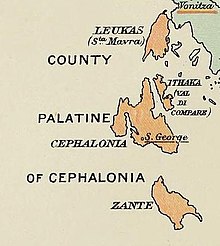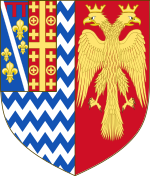County Palatine of Cephalonia and Zakynthos
| County Palatine of Cephalonia and Zakynthos Παλατινή Κομητεία της Κεφαλονιάς και της Ζακύνθου(Greek) Palatiní Komiteía tis Kefaloniás kai tis Zakýnthou | |||||||||||
|---|---|---|---|---|---|---|---|---|---|---|---|
| Vassalstate of various countries,de factoautonomous | |||||||||||
| 1185–1479 | |||||||||||
 County Palatine of Cephalonia and Zakynthos | |||||||||||
| Capital | Castle of Saint George | ||||||||||
| Government | |||||||||||
| • Type | County palatine | ||||||||||
| Count palatine | |||||||||||
• 1185–1195 | Margaritus of Brindisi | ||||||||||
• 1448–1479 | Leonardo III Tocco | ||||||||||
| Historical era | Middle Ages | ||||||||||
• Established | 1185 | ||||||||||
• Divided by theOttoman Empireand theRepublic of Venice | 1479 | ||||||||||
| |||||||||||
| Today part of | Greece | ||||||||||
TheCounty Palatine of Cephalonia and Zakynthosexisted from 1185 to 1479 as part of theKingdom of Sicily.The title and the right to rule theIonian islandsofCephaloniaandZakynthoswas originally given toMargaritus of Brindisifor his services toWilliam II,King of Sicily, in 1185.
Following Margaritus, the county passed on to a branch of theOrsini familyuntil 1325, when it passed briefly toAngevinsand then, from 1357, to theTocco family.The Tocco used the county as a springboard for their acquisition of lands in the Greek mainland, and were successful in gaining control over theDespotate of Epirusin 1411. However, facing the advance of theOttoman Turksthey successively lost their mainland territories and were once again reduced to theCounty Palatine,which they held until 1479, when it wasdivided betweenVeniceand the Ottomans. Zakynthos was put under the direct rule of Venice.
History[edit]
The beginning of theFrankishconquest in the islands ofCephalonia,ZakynthosandIthacawas linked with the pirate and admiral of theSicilianfleetMargaritus of Brindisi,known to the chroniclers of the late 12th century. He developed significant activity as the privateer ofWilliam II,Norman King of Sicily.[1]In Latin documents of 1192 and 1193, he signed in Greek as Μαργαρίτος Βρεντεσίνος αμιράς κόμης Μελιτήιος (Margaritus Admiral, Count of Malta).[2]Irrespective of Margaritus’ unclear descent, it is certain that William, after the Norman invasion of 1185 against the Byzantine provinces, granted him the new Norman acquisitions in theIonian Sea,in exchange for the services he had offered to the Norman.[3][4]
Ten years later, in 1195,Matthew or Maio Orsini,who is generally considered a scion of the nobleRomanOrsini family,succeeded Margaritus as the ruler of the Ionian Islands.[5]In order to secure his position, Matthew recognized the dominion ofVenicein 1209[6]and of thePopein 1216[7]and later of thePrincipality of Achaeain 1236.[8]During that same period the Orthodox bishopric of the islands was abolished, the Episcopal thrones were occupied by Latins and the feudal system was put into force.[9]The successor of Matthew,Richard,the "most noble count of the palace and lord of Cephalonia, Zakynthos and Ithaca", authenticated in 1264 the estates of the Latin bishopric of Cephalonia.[10]During the reign of the latter Frankish ruler, Ithaca had become a refuge for pirates.[11]
The Orsini family did not only rule the Ionian Islands but also conqueredEpirusin early 14th century, thus acquiring the title of 'the despot' as well.[12][13]Certain members of the family embraced the Orthodox dogma and married Greek women.[14]After the death ofJohn II Orsiniin 1335, the islands were occupied by theAnjou,who, as rulers of Achaea, had the islands under their suzerainty until then.[15]
The Angevin occupation lasted until 1357, when the said Greek territory was ceded to the Italian family of theTocchi,who remained in power for over a century and secured unity in the governance of those three Ionian Islands. In 1357,Robert of Tarantoceded Cephalonia, Zakynthos and Ithaca to the governor ofCorfu,Leonardo I Tocco,as reward for the services he had provided when he was a captive of theKing of Hungary.[16][17]
After the expansion of his dominion to Leukas, Leonardo I Tocco attempted to reinforce his position by entering into family relations with the powerfulFlorentinefamily of theAcciaiuoli.[17]
This policy gave the family of the Tocchi increased power, which reached its peak during the 15th century with its expansion to the continental coast, afterCarlo I ToccoconqueredIoannina(1411)[18]andArta(1416).[19]He received the title of despot by theByzantine emperorManuel II Palaiologosand maintained the Byzantine tradition.[20]Seated in the islands of the Ionian Sea or in the acquisitions in Central Greece, the dynasty of the Tocchi attempted to win over the populations by ceding to the seigneurs, according to theChronicle of the Tocco,"inheritances", "estates", "kratimata" and "pronoias". An example of this is the familyGalati,who received privileges and estates from the Tocco on the island ofIthaca.[21]Following an analogous policy on the religious front,Leonardo III(1448–1479), the last of the Tocchi dynasty, reinstated the Orthodox episcopal throne of Cephalonia that had been abolished by the Orsini.[9]
Venice was not pleased with the increased influence of the Tocchi. The downfall of the duchy of the Tocchi by theTurks(1479) gave the opportunity to the Serenissima to intervene resolutely in the Ionian Sea and succeeded, through the treaty of 1484, in annexing Zakynthos and, in 1500, Cephalonia and Ithaca.[22]
Counts Palatine of Cephalonia and Zakynthos[edit]
Orsini family[edit]
- Matthew Orsini,1195 – after 1238
- Richard Orsini,before 1260 – 1304
- John I Orsini,1304–1317
- Nicholas Orsini,1317–1323
- John II Orsini,1323–1325
Angevins[edit]
- John of Gravina,1325–1336
- Robert of Taranto,1336–1357
House of Tocco[edit]

- Leonardo I Tocco,1357–1376
- Charles I Tocco,1376–1429
- Charles II Tocco,1429–1448
- Leonardo III Tocco,1448–1479
References[edit]
- ^ODB,"Ionian Sea" (T. E. Gregory), p. 1007.
- ^Leon-Robert Menager, "Amiratus-Αμηράς: L'emirat et les origines de l'amiraute (XIe-XIIIe siecles)", Paris, S.E.V.P.E.N., p. 258, 1960
- ^Soustal & Koder 1981,pp. 58, 176.
- ^ODB,"Kephalenia" (T. E. Gregory), pp. 1122–1223.
- ^Kiesewetter 2006,p. 339.
- ^Miller 1908,p. 47.
- ^Kiesewetter 2006,p. 348.
- ^Jean LongnonL’Empire Latin de Constantinople et la Principauté de Morée,Payot, Paris 1949, p. 175
- ^abMiller 1908,p. 484.
- ^Miller 1921,p. 262.
- ^Miller 1908,p. 157.
- ^Nicol 2010,p. 82.
- ^Polemis 1968,pp. 95 (note 2), 98–99.
- ^Nicol 2010,pp. 81–107, 107–121.
- ^Nicol 2010,p. 101.
- ^ODB,"Tocco" (A.-M. Talbot), p. 2090.
- ^abMiller 1908,p. 292.
- ^Zečević 2014,p. 80.
- ^Zečević 2014,p. 81.
- ^Zečević 2014,pp. 82–84.
- ^Moraitinis-Patriarcheas, Eleutherios. (2002).Nikolaos Galatis ho Filikos.Kedros. pp. 25–9.ISBN960-04-2189-7.OCLC1085554299.
- ^Setton 1978,p. 515.
Sources[edit]
- Kazhdan, Alexander,ed. (1991).The Oxford Dictionary of Byzantium.Oxford and New York: Oxford University Press.ISBN0-19-504652-8.
- Kiesewetter, Andreas (2006). "Preludio alla Quarta Crociata? Megareites di Brindisi, Maio di Cefalonia e la signoria sulle isole ionie (1185-1250)". In Gherardo Ortalli; Giorgio Ravegnani; Peter Schreiner (eds.).Quarta Crociata. Venezia - Bisanzio - Impero latino. Atti delle giornate di studio. Venezia, 4-8 maggio 2004(in Italian). Venice: Istituto veneto di scienze, lettere ed arti.ISBN8888143742.
- Miller, William(1908).The Latins in the Levant: A History of Frankish Greece (1204–1566).London: John Murray.OCLC563022439.
- Miller, William(1921).Essays on the Latin Orient.Cambridge: Cambridge University Press.OCLC457893641.
- Nicol, Donald MacGillivray(2010).The Despotate of Epiros 1267–1479: A Contribution to the History of Greece in the Middle Ages.Cambridge University Press.ISBN978-0-521-13089-9.
- Polemis, Demetrios I. (1968).The Doukai: A Contribution to Byzantine Prosopography.London: The Athlone Press.OCLC299868377.
- Setton, Kenneth M.(1978).The Papacy and the Levant (1204–1571), Volume II: The Fifteenth Century.Philadelphia: The American Philosophical Society.ISBN0-87169-127-2.
- Soustal, Peter; Koder, Johannes (1981).Tabula Imperii Byzantini, Band 3: Nikopolis und Kephallēnia(in German). Vienna:Verlag der Österreichischen Akademie der Wissenschaften.ISBN978-3-7001-0399-8.
- Zečević, Nada (2014).The Tocco of the Greek Realm: Nobility, Power and Migration in Latin Greece (14th – 15th Centuries).Belgrade: Makart.ISBN978-8687115118.






